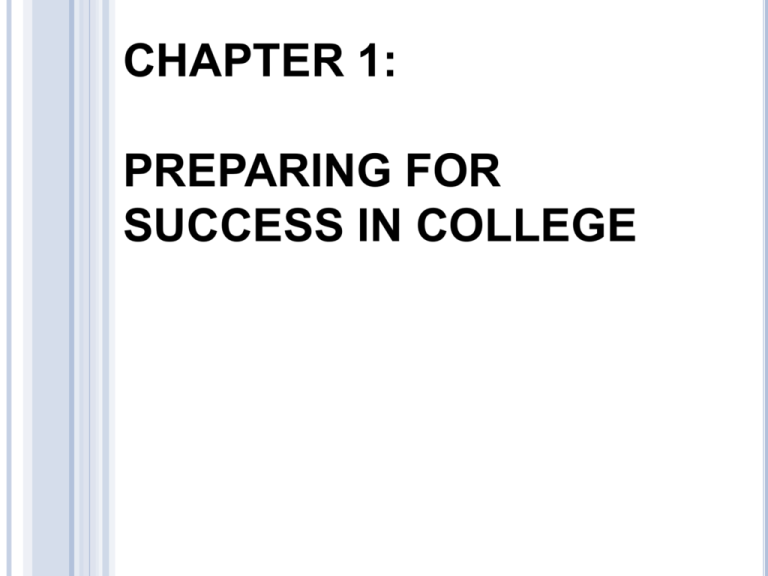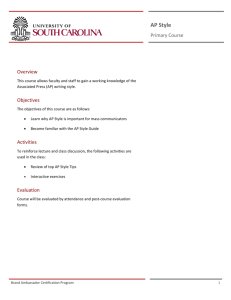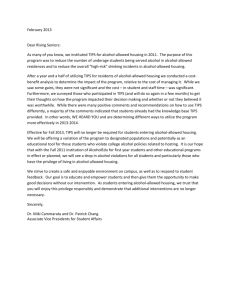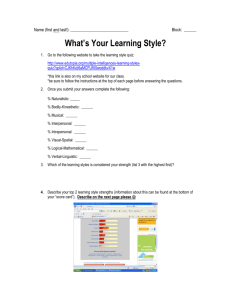
CHAPTER 1:
PREPARING FOR
SUCCESS IN COLLEGE
What’s In It for You?
• Reasons for Going to College
• The Advantages of a College Education
• Improved Opportunities for Financial Security
• Obtaining the Necessary Skills for Today's Workforce
• The College Advantage
• The Personal Benefits of Going to College
• You're Part of a Diverse College Population
• Getting Involved in Your College Community
•
•
•
•
Getting Socially Involved
Tips for Getting Socially Involved
Getting Academically Involved
Tips for Getting Academically Involved
• Finding the Right Balance
• Getting Off to a Good Start in Your Classes
Benefiting from Resources and Services
•
•
•
•
•
•
Using Your College Catalog/Student Handbook
Academic Requirements and Procedures
Student Services
Using Your Placement Office
Working with the System
Tips for Making the System Work for You
Getting There Financing Your Education
• Know Where Your Money Goes
• Tips for Reducing Expenses
• Working Through School
•
•
•
•
•
•
Coping with Credit Cards: Going Plastic
Tips for Coping with Credit Cards
Identity Theft: What You Should Know
Tips for Minimizing Your Risk for Identity Theft
Financial Aid
Student Financial Aid and Scholarship Information on the
Web
Balancing School, Work, Family, and Friends
•
•
•
•
•
Strategies for Work and School
Tips for Managing Work and School
Strategies for Family and School
Tips for Managing Children and School
Child Care
• Communicating with Others
• Online Social Networking
• Security Dangers of Online Social Networking
• Personal Risks of Online Social Networking
CHAPTER 2:
LEARNING TO THINK
CRITICALLY
What’s In It for You?
• What Is Critical Thinking?
• The Importance of Critical Thinking to Your Professional and
Personal Life
• What Qualities Do Critical Thinkers Possess?
• The Process and Tools for Critical Thinking
• Tools for Critical Thinking
• Basic Guidelines for Critical Thinking
• Developing Critical Reading Skills
• Questioning: The Tool of Critical Reading
• Ten Critical Thinking Questions to Probe Your Reading
• Critical Thinking: You and the Media
•
•
•
•
•
•
•
Tips for Thinking Critically About the Media Highlights
Discussion Questions
Activities
Practicing for Academic Success
Practicing for Career Success
Practicing for Personal Success
In Your Own Words
CHAPTER 3:
PRESENTING YOUR
BEST WORK
What’s In It for You?
•
•
•
•
•
The basics of effective writing strategies.
How to write a well organized research paper.
Tips for producing quality memos, letters, and reports for work.
Strategies for overcoming the fear of public speaking.
Tips for making interesting, well organized oral presentations.
The Basic Steps to Effective Writing
• Step 1: Choosing a Topic for a Writing Assignment
• Step 2: Prewriting
• Step 3: Organizing
• Step 4: Writing a Rough Draft
• Step 5: Revising
Practice, Practice, Practice
Writing and Computers
Tips for Writing with Computers
The Research Paper
•
•
•
•
•
•
•
Know the Ropes
Choose a Topic
Gather Information
Select Information from Your Resources
Construct an Outline
Write Rough Draft(s)
Revise and Polish
Writing for Work
•
•
•
•
Writing Memos
Tips for Writing a Better Memo
Writing Business Letters
Writing Reports
Making Presentations
• Tips for Preparing a Presentation
• Tips for Making Presentations
SAMPLE OF A MENU DRIVEN PRESENTATION
CHAPTER 4:
LEADERSHIP, ETHICS,
AND RESPONSIBILITY
What's In It for You
This chapter explores the important traits of
leadership, ethics, and responsibility.
College provides a perfect environment for you
to work on developing your leadership skills!
LEADERSHIP
WHAT’S THE ONE THING THAT
ALL LEADERS HAVE IN COMMON?
FOLLOWERS!
Adaptable
Approachable
Authentic
Charismatic
Collaborative
Committed
Compassionate
Competent
Consistent
Decisive
Dependable
Disciplined
Effective
Efficient
Empathetic
Engaged
Ethical
Family
Oriented
Firm
Flexible
Focused
Forward
Thinker
Goal
Oriented
Honorable
Influential
Innovative
Intelligent
Listener
Opportunistic
Optimistic
Organized
Outgoing
Productive
Resilient
Resourceful
Responsible
Role
Model
Sense of
Humor
Spiritual
Stable
Steadfast
Straight
Forward
Tactful
Team
Player
Tolerant
Transcendent
Visible
Visionary
Wise
THEORIES OF LEADERSHIP
• Behavioral – assumes people lead because they care about
people, respond to other people’s needs, are genuinely
interested in other people, can select the best approach to a
problem, and are able to be decisive in crisis situations.
• Contingency – suggests that leadership is variable, that it
depends on the particular situation, the characteristics of the
people involved, the context of the particular group, the style
of the leader, and whether the leader is trusted or not.
SOURCES OF POWER
In most societies, the group selects a leader.
What are some other ways people select leaders?
TYPES OF LEADERS: BASIC LEADERSHIP TRAITS
WHAT IS A SUCCESSFULLY LEADER?
TIPS FOR DEVELOPING LEADERSHIP SKILLS
•
•
•
•
•
•
Read
Develop your vocabulary
Be fair
Get involved
Brainstorm ideas
Treat people with respect
ETHICS AND RESPONSIBILITY
• Ethics – a set of values.
ETHICAL PRINCIPLES
•
•
•
•
•
Respect autonomy (other people’s rights)
Do no harm
Benefit others
Be just
Be faithful
ETHICAL TERMS
• Ethics – a set of values based on moral beliefs and attitudes
• Morality – the rules, or mores, which an individual or group has
about what is right or wrong, good or evil
• Mores – the values and beliefs of a particular culture
• Value – that which we choose to be worthwhile or believe to
have merit, such as truthfulness, respect for others,
confidentiality, etc.
• Value system – the way in which we organize, prioritize, and
make decisions based on our values
• Virtues – values turned into actions
What would you do?
-
Find a wallet…
Hit a car and no one sees it…
Someone asks you to help them cheat on an exam…
Cashier gives you back too much money…
CHOICES AND CHALLENGES!!!
ACADEMIC INTEGRITY!!!
RIGHTS AND RESPONSIBILITIES
&
BILL OF RIGHTS
Student Responsibilities
You have the responsibility to take control of
your own learning process.
You have the responsibility to develop skills
for learning, test-taking, and problemsolving.
You have the responsibility to think and act
positively.
You have the responsibility to ask questions
when you don't understand something
You have the responsibility to attend
classes.
You have the responsibility to participate
actively in class.
You have the responsibility to complete
assignments.
You have the responsibility to help others
when asked.
You have the responsibility not to have a
negative impact on other students or the
instructor.
Student Bill of Rights!
You have the right to an education.
You have the right to take control of your
learning process.
You have the right to be treated as an
adult.
You have the right to define success in
your own terms.
You have the right to feel good about
yourself regardless of your abilities.
You have the right to ask questions.
You have the right to be treated fairly.
You have the right to need extra help.
You have the right to say you don't
understand.
You have the right not to be put down.
You have the right to evaluate your
instructors.
CHAPTER 5:
SHARING OUR DIVERSE
WORLD
WHAT'S IN FOR YOU?
•
The advantage of our diverse world
•
Ways to overcome stereotypes, prejudice, and discrimination
•
Tips for understanding and relating to students with diverse
backgrounds
•
The significance of body language
•
Effective listening skills
•
How to communicate assertively
•
Strategies for dealing with sexual harassment
•
How to protect yourself from crime
•
Tips to protect yourself from rape and date rape
TAKING ADVANTAGE OF OUR DIVERSE WORLD
Are we really GRAMFAM????
We are culturally diverse in that the world is a mixture
of people of different colors, backgrounds, abilities and faiths.
STEROTYPES, PREJUDICE, AND DISCRIMINATION
•
Stereotyping means attributing the perceived characteristics of
a category of people to every individual within that category,
leaving no room for the specific qualities within each person.
•
Prejudice means pre-judging. It’s judging a person on what
you think you know about them or the group of people they
come from.
•
Discrimination is a action based on prejudice; it is the unequal
treatment of members of a group.
Relating to Students with Diverse Backgrounds
Tips for Eliminating Prejudice and Discrimination
and Improving Relationships
•
•
•
•
•
•
•
•
Learn to recognize prejudicial attitudes in yourself.
Look for the best in others
Practice inclusion
Be the person who asks the new student to be a part of
the group
Speak up for those who others are putting down
Learn more about other people
Get involved
Be kind!
COMMUNICATING
EFFECTIVE LISTENING IS PROBABLY THE FOUNDATION FOR GOOD
RELATIONSHIPS AND GOOD COMMUNICATION BETWEEN PEOPLE.
BECOME MORE AWARE OF WAYS THAT YOU
MAY WANT TO IMPROVE YOUR LISTENING SKILLS.
LISTENING SKILLS ASSESSMENT
(CLICK ON THE ICON TO TAKE THE LISTENING SKILLS ASSESSMENT)
REFLECTIVE LISTENING
• Reflective listening is an active form of listening which
communicates that you understand what the speaker has said.
• Paraphrasing is repeating what someone has said – to let
them know that you’ve been paying attention and know the
message he/she is trying to get across (reflecting).
ASSERTIVE COMMUNICATION
• Assertive communication is expressing your point of view by
standing up for yourself and being direct – while still respecting
others.
QUALITIES OF AN ASSERTIVE COMMUNICATOR
• When things are clear, assertive communicators will ask
questions.
• Assertive communicators is able to say, “I was wrong about
that” and “I’m beginning to see your point”, and “I never looked
at it that way before.”
• Assertive communicators know that the point of the
conversation is to exchange ideas – not win a debate.
QUALITIES OF AN NON-ASSERTIVE COMMUNICATOR
• Individuals are usually timid and allow others to violate their
rights by failing to express their honest feelings and thoughts.
• Non assertive communicators want to please others and avoid
conflicts.
• Non assertive communicators are afraid to express their view.
QUALITIES OF AN AGGRESSIVE COMMUNICATOR
• Individuals are usually insecure and they express these
feelings by responding in ways that do not show respect for
others – they often “put down” others to make their point.
• Aggressive communicators tend to shout or speak harshly
and get impatient.
• Aggressive communicators think of themselves first and,
therefore don’t think much about the feelings of others.
DEALING WITH SEXUAL HARASSMENT
Most women experience sexual harassment in the form of unwelcome sexual advances,
requests for sexual favors, and other forms of unwanted verbal and physical conduct of a
sexual nature.
The conduct can be as blatant as grabbing or touching, or as subtle as hints and
suggestions.
Pervasive displays of nude or pornographic pictures at the workplace also have been ruled
harassment.
The harassment can be carried out in forms of demanding sexual favors for grades or
promotion, or to maintain employment.
The evidence also shows that women are more frequently exposed to sexual harassment
than men.
Studies have shown that sexual harassment is more about power than sex, and about the
harasser's feelings of insecurity.
DEALING WITH SEXUAL HARASSMENT
• If you are harassed sexually at school, report it first to a school counselor.
• This person can guide you to your school's procedures for complying with sexual
harassment laws.
• Your local Office for Civil Rights and the equal Employment Opportunity Commission
also can guide you in the proper procedures for taking action against sexual harassment.
• Sexual harassment is unacceptable conduct and should not be tolerated.
• It builds barriers between men and women.
• Both sexes need to be more aware of sexual harassment.
• Both sexes need to assert themselves when they are offended by inappropriate conduct
at school, at work, and in other areas of life.
• Both men and women need to expect respect from each other and to speak up when
they see sexual harassment occurring.
UNDERSTANDING RAPE AND DATE RAPE
• Rape is a crime of violence, not sex.
• It is emotionally devastating not only to the victim but to the victim's family and close
friends, as well as to society in general.
• Rape is forced sexual intercourse where physical force, threats, and fear are used to
overpower and control the victim.
• If it is against your will, it is against the law.
• Rape is a felony.
• Date rape in particular has received a lot of media attention in recent years.
• A victim sometimes is thought to have been "asking for it" because she dressed or
behaved in a provocative way. The fact is, rape is a crime of violence, not sex. Rapists
are not attracted to their victims in a sexual sense; they are attracted to them as
people who seem weak and can be dominated by force. Victims feel the effect of the
attack for a long time. Not only is the memory of the attack painful, as well as any
physical injuries, but victims also have to deal with family, friends, and acquaintances
who may not know how to respond.
UNDERSTANDING RAPE AND DATE RAPE
• If You're a Victim of Rape
• If you are a victim of rape or know someone close to you who was a victim of rape,
report the crime at once.
• Call the police or the emergency number "911."
• Alternatively, call your community rape hotline; hotline numbers usually are located in
the front of your telephone book under Community Service Numbers. Members of the
hotline will inform you of your options, explain legal processes, and provide counseling
and assistance through the medical exam to court proceedings, and after.
• Remember that the person who is raped is not at fault—the perpetrator is. The person
who was raped did not "ask for it"; the person who was raped was the victim of a
crime, not the guilty party.
• There are complicated, painful feelings involved following rape; get the assistance of a
rape crisis center or another counselor to help get you through the experience. Help is
out there.
CHAPTER 6: MAKING HEALTHY CHOICES
•
•
•
•
•
•
•
•
•
•
•
•
•
•
What’s In It for You?
Managing Stress
Kinds of Stress
Stress Management Strategies
Tips for Coping with Stress Healthy Eating
Tips for Balanced Eating
The USDA Dietary Guidelines
Managing Your Weight
Tips for Controlling Your Weight
Eating Disorders
The Benefits of Exercise
Developing a Personal Exercise Program
Tips for Strength Building
Tips for Sticking to Your Exercise Program
There were many moments when the young artist
doubted his ability for the task. In January 1509, he wrote
his father, “My work does not seem to go ahead in a way
to merit anything. This is due to the difficulty of the work
and also because it is not my profession. In
consequence, I lose my time fruitlessly.” But he persisted,
and the result was a work that set new standards and
has stood the test of time.
Michelangelo, as he writes about his work on the
Sistine Chapel in Rome
CHAPTER 6: MAKING HEALTHY CHOICES (CONTINUED)
•
•
•
•
•
•
•
•
•
•
Considering the Risks and Options of Sex
Sexual Relationships
Birth Control
Preventing Sexually Transmitted Diseases
Understanding Substance Abuse
Alcohol
Tips for Responsible Drinking
Smoking
Tips for Quitting Smoking—Kick It Before It Kicks You
Other Drugs Highlights
CHAPTER 7: PLANNING FOR YOUR CAREER
•
•
•
•
•
•
•
•
•
What’s In It for You?
Know Yourself
Assessing Your Workplace Values
Assessing Your Interests
Assessing Your Occupational Personality Type
Assessing Your Skills
Investigating Career Options
Informational Interviews
Tips for Conducting Informational Interviews Job Search
Strategies
• Job Searching via the Web
• Using Your College Career Services Office
• Networking as Part of Your Job Search
CHAPTER 7: PLANNING FOR YOUR CAREER (CONTINUED)
•
•
•
•
•
•
•
•
•
•
•
•
Tips for Successful Networking via Social Media
Tips for Successful Job Search Networking—In Person
Using Your Portfolio to Market Yourself for the Job
Your Resume
Tips for Writing an Effective Resume
Thinking Outside the Box Marketing
Major Components of a Resume
How to Create a Scannable Resume Cover Letters
Tips for Writing Effective Cover Letters Job Applications
Tips for Completing Job Applications Job Interviews
At the Interview
Common Interview Questions
CHAPTER 7: PLANNING FOR YOUR CAREER (CONTINUED)
•
•
•
•
•
•
•
•
•
Tips on Preparing for a Job Interview
Interview Follow Up—Thank You
Highlights
Discussion Questions
Activities
Practicing for Academic Success
Practicing for Career Success
Practicing for Personal Success
In Your Own Words
CHAPTER 8: INFORMATION TECHNOLOGY
•
•
•
•
•
•
•
•
•
•
•
•
•
What’s In It for You?
Information Boom to Information Overload
Should I Buy a New Computer or Upgrade?
Tips for Upgrading or Purchasing a New Computer
Internet Basics
The Way of the Web Searching and Researching via the Web
Web Directories
Search Engines
Metasearch Engines
Tips for Searching the Web Using the Web for Class Research
Tips for Evaluating Information on the Web
Style for Citing Online Information
Email Practices and Etiquette for College, Career, and Life
CHAPTER 8: INFORMATION TECHNOLOGY (CONTINUED)
• Tips for Email Etiquette and Other Considerations
• Keeping Up with Technology to Keep Up with the Changing
Workplace
• Safety and Security Tips for You and Your Computer









